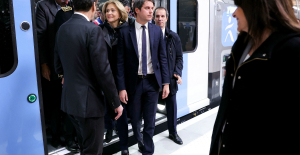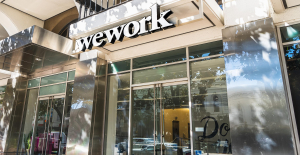In Nîmes (Gard)
Two sachets of M
Low noise, Lidl is gradually moving forward with the installation of electric charging stations at the entrance to its stores. The distributor has just opened its sixth e-station in Nîmes (Gard) in less than a year, after a first test in Villefranche-sur-Saône (Rhône) last November. A new business for the brand, which until now was absent from fuel distribution - only a few supermarkets taken over from other brands have retained this service, which the German group does not manage directly.
Like all major retailers, Lidl is required by law to install electric charging stations. On the one hand, the mobility orientation law (Lom) requires that 5% of parking spaces open to the public (from 10 spaces) offer a connection; and on the other, the Alur law encourages the deployment of charging solutions since the spaces dedicated to them allow distributors to increase their number of authorized parking spaces. Thus, Lidl already has around 3,600 charging points scattered across these 805 supermarkets, around 4% of the public charging base in France. Free from 2016 to 2021, charging is now charged at 22 kW slow-charging terminals. By 2025, to comply with the law, the brand must have 9,000 to 10,000 charging points.
Lidl is considering turning this constraint into an opportunity by developing real e-stations. “We are using the codes of the gas station. Although there are three installed powers - 22 kW, 90 kW, and 180 kW - there are currently only two rates: 25 and 40 cents per kWh (the rate for individuals is 0.2 276 euro/kWh, Editor’s note). Hybrid vehicles can only charge at 22kW terminals, which is why they are not positioned in the same place,” explains Claude-Henri de Gail, e-mobility project manager at the German brand. Lidl is however launching step by step. “At this stage, e-stations are experimental projects. We are going to let them live a little to see if they are popular and if the investment is worth sustaining,” specifies the manager.
Although the investment cost is not negligible, the revenue potential is there. E-stations allow customers to refuel in thirty minutes… the time it takes to do their shopping. But, a notable difference compared to the fuel strategy of other distribution brands which generally earn only one or two cents per liter, Lidl does not intend to make its e-stations just a flagship product intended to satisfy existing customers. or attract a new one. “We are looking for profitability and want a more premium offering. Furthermore, we have completely internalized the design of our stations and developed internal expertise. It’s a new job for us that we don’t want to delegate to an intermediary,” explains Matthieu Fréchon, the national technical director of Lidl.
To date, the brand has noted “between 50% and 300% higher occupancy of e-stations compared to the charging points typically found in other supermarkets.”

 What is chloropicrin, the chemical agent that Washington accuses Moscow of using in Ukraine?
What is chloropicrin, the chemical agent that Washington accuses Moscow of using in Ukraine? Poland, big winner of European enlargement
Poland, big winner of European enlargement In Israel, step-by-step negotiations for a ceasefire in the Gaza Strip
In Israel, step-by-step negotiations for a ceasefire in the Gaza Strip BBVA ADRs fall almost 2% on Wall Street
BBVA ADRs fall almost 2% on Wall Street Children born thanks to PMA do not have more cancers than others
Children born thanks to PMA do not have more cancers than others Breast cancer: less than one in two French women follow screening recommendations
Breast cancer: less than one in two French women follow screening recommendations “Dazzling” symptoms, 5,000 deaths per year, non-existent vaccine... What is Lassa fever, a case of which has been identified in Île-de-France?
“Dazzling” symptoms, 5,000 deaths per year, non-existent vaccine... What is Lassa fever, a case of which has been identified in Île-de-France? Sánchez cancels his agenda and considers resigning: "I need to stop and reflect"
Sánchez cancels his agenda and considers resigning: "I need to stop and reflect" “Amazon product tester”: the gendarmerie warns of this new kind of scam
“Amazon product tester”: the gendarmerie warns of this new kind of scam “Unjustified allegations”, “promotion of illicit products”… Half of the influencers controlled in 2023 caught by fraud repression
“Unjustified allegations”, “promotion of illicit products”… Half of the influencers controlled in 2023 caught by fraud repression Extension of the RER E: Gabriel Attal welcomes a “popular” ecology project
Extension of the RER E: Gabriel Attal welcomes a “popular” ecology project WeWork will close 8 of its 20 shared offices in France
WeWork will close 8 of its 20 shared offices in France “We were robbed of this dignity”: Paul Auster’s wife denounces the betrayal of a family friend
“We were robbed of this dignity”: Paul Auster’s wife denounces the betrayal of a family friend A masterclass for parents to fill in their gaps before Taylor Swift concerts
A masterclass for parents to fill in their gaps before Taylor Swift concerts Jean Reno publishes his first novel Emma on May 16
Jean Reno publishes his first novel Emma on May 16 Cannes Film Festival: Meryl Streep awarded an honorary Palme d’Or
Cannes Film Festival: Meryl Streep awarded an honorary Palme d’Or Omoda 7, another Chinese car that could be manufactured in Spain
Omoda 7, another Chinese car that could be manufactured in Spain BYD chooses CA Auto Bank as financial partner in Spain
BYD chooses CA Auto Bank as financial partner in Spain Tesla and Baidu sign key agreement to boost development of autonomous driving
Tesla and Baidu sign key agreement to boost development of autonomous driving Skoda Kodiaq 2024: a 'beast' plug-in hybrid SUV
Skoda Kodiaq 2024: a 'beast' plug-in hybrid SUV The home mortgage firm rises 3.8% in February and the average interest moderates to 3.33%
The home mortgage firm rises 3.8% in February and the average interest moderates to 3.33% This is how housing prices have changed in Spain in the last decade
This is how housing prices have changed in Spain in the last decade The home mortgage firm drops 10% in January and interest soars to 3.46%
The home mortgage firm drops 10% in January and interest soars to 3.46% The jewel of the Rocío de Nagüeles urbanization: a dream villa in Marbella
The jewel of the Rocío de Nagüeles urbanization: a dream villa in Marbella Europeans: a senior official on the National Rally list
Europeans: a senior official on the National Rally list Blockade of Sciences Po: the right denounces a “drift”, the government charges the rebels
Blockade of Sciences Po: the right denounces a “drift”, the government charges the rebels Even on a mission for NATO, the Charles-de-Gaulle remains under French control, Lecornu responds to Mélenchon
Even on a mission for NATO, the Charles-de-Gaulle remains under French control, Lecornu responds to Mélenchon “Deadly Europe”, “economic decline”, immigration… What to remember from Emmanuel Macron’s speech at the Sorbonne
“Deadly Europe”, “economic decline”, immigration… What to remember from Emmanuel Macron’s speech at the Sorbonne These French cities that will boycott the World Cup in Qatar
These French cities that will boycott the World Cup in Qatar Champions Cup: Toulouse with Flament and Kinghorn against Harlequins, Ramos replacing
Champions Cup: Toulouse with Flament and Kinghorn against Harlequins, Ramos replacing Tennis: still injured in the arm, Alcaraz withdraws from the Masters 1000 in Rome
Tennis: still injured in the arm, Alcaraz withdraws from the Masters 1000 in Rome Sailing: “Like a house that threatens to collapse”, Clarisse Crémer exhausted and in tears aboard her damaged boat
Sailing: “Like a house that threatens to collapse”, Clarisse Crémer exhausted and in tears aboard her damaged boat NBA: Patrick Beverley loses his temper and throws balls at Pacers fans
NBA: Patrick Beverley loses his temper and throws balls at Pacers fans


















